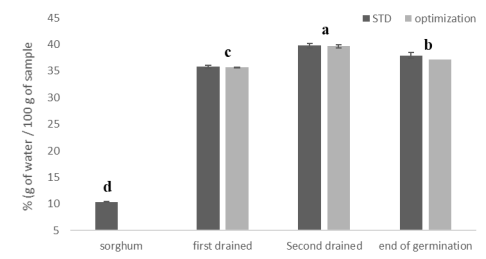
Submission to VIJ 2024-09-23
Keywords
- kablé-missine, malting, mashing, Brix, pH.
Copyright (c) 2024 Diantom Agoura, Ayah Mazabalo, Goka M. Gott’Liebe, Melila Mamatchi, Agblekpe A. Kokouvi, Tchacondo Tchadjobo

This work is licensed under a Creative Commons Attribution 4.0 International License.
Abstract
Kablé-missine is a traditional alcoholic beverage predominantly brewed in Northern region of Togo. Despite its widespread consumption and use in various festivities, its quality varies enormously depending on the individual brewing methods. This study aimed to optimize the brewing process of local sorghum beer, kablé-missine, with a particular focus on malting and mashing. Local sorghum grains were subjected to steeping, and key parameters including moisture content during malting, pH, and Brix of the wort were evaluated. The moisture content significantly increased during the steeping phase (39.77 ± 0.44%) and subsequently decreased during germination (37.93 ± 0.53%). The pH of the acidification process was adjusted to 3.11 ± 0.02, and the Brix level significantly increased with extended boiling time in both samples. Moreover, using a limited amount of water during mashing effectively reduced the boiling time.
References
- Dicko, M. H., Gruppen, H., Traoré, A. S., Voragen, A. G., & Van Berkel, W. J. (2006). Sorghum grain as human food in Africa: relevance of content of starch and amylase activities. African journal of biotechnology, 5(5), 384-395.
- Awika, J. M., & Rooney, L. W. (2004). Sorghum phytochemicals and their potential impact on human health. Phytochemistry, 65(9), 1199-1221.
- Novellie, L., & De Schaepdrijver, P. (1986). Modern developments in traditional African beers. Progress in industrial microbiology, 23, 73-157.
- Banigo, E. O., Aina, A., & Ossai, G. E. (1987). A study of the traditional burukutu manufacturing practice in Nigeria. Journal of Food and Agriculture, 2, 83-89.
- Chamunorwa, A.T., Feresu, S.B., & Mutukumira, A.N. (2002). Identification of lactic acid bacteria isolated from opaque beer (Chibuku) for potential use as a starter culture. Journal of Food Technology in Africa, 7, 93-97.
- Maoura, N., Mbaiguinam, M., Gaillardin, C., & Pourquie, J. (2006). Suivi technique, analytique et microbiologique de la « bili bili », bière traditionnelle tchadienne. Afrique Science : Revue Internationale des Sciences et Technologie, 2(1).
- Okafor, N. (2007). Modern industrial microbiology and biotechnology. U.S.A: Science Publishers Owuama, C. I. (1999). Brewing beer with sorghum. Journal of the Institute of Brewing, 105(1), 23-34.
- Nanadoum, M., & Pourquie, J. (2009). Sorghum beer: production, nutritional value and impact upon human health. In Beer in health and disease prevention (pp. 53-60). Academic Press.
- Polycarpe Kayodé, A. P., Adegbidi, A., Hounhouigan, J. D., Linnemann, A. R., & Robert Nout, M. J. (2005). Quality of farmers’ varieties of sorghum and derived foods as perceived by consumers in Benin. Ecology of food and Nutrition, 44(4), 271-294.
- Lyumugabe, F., Gros, J., Nzungize, J., Bajyana, E., & Thonart, P. (2012). Characteristics of African traditional beers brewed with sorghum malt: a review. Biotechnology Agronomy Society and Environment, 16(4), 509-530.
- Coffi Aholou, C. (2010). Construction identitaire et urbaine autour du cabaret à Lomé (Togo). Hommes & Migrations, 1283(1), 32-41.
- Novidzro, K. M., Melila, M., Houndji, B. V. S., Koudouvo, K., Dotse, K., & Koumaglo, K. H. (2018). Étude de quelques caractéristiques physico-chimiques de «Tchoukoutou», un type de bières locales produit au Togo et évaluation de la performance de quatre méthodes de détermination du degré alcoolique. International Journal of Biological and Chemical Sciences, 12(6), 2871-2884.
- Kayodé, A. P., Hounhouigan, D. J., Nout, M. J., & Niehof, A. (2007). Household production of sorghum beer in Benin: technological and socio‐economic aspects. International Journal of Consumer Studies, 31(3), 258-264.
- AOAC. 1995. « Official methods of analysis, 16th Ed. ». Association of official analytical chemists. Washington DC, USA. Sci. Educ.
- Desobgo, Z. S., Naponni, F. Y., & Nso, E. J. (2013). Caractérisation des moûts et bières du sorgho Safrari houblonnés avec Vernonia amygdalina et Nauclea diderrichii. International journal of innovation and applied studies, 2(1), 83-91.
- Desobgo, Z. S., Naponni, F. Y., & Nso, E. J. (2013). Caractérisation des moûts et bières du sorgho Safrari houblonnés avec Vernonia amygdalina et Nauclea diderrichii. International journal of innovation and applied studies, 2(1), 83-91.
- Bello, M., Tolaba, M. P., & Suarez, C. (2004). Factors affecting water uptake of rice grain during soaking. LWT-Food science and Technology, 37(8), 811-816
- Solomon, W. K. (2007). Hydration kinetics of lupin (Lupinus albus) seeds. Journal of Food Process Engineering, 30(1), 119-130.
- Kashiri, M., Kashaninejad, M., & Aghajani, N. J. L. A. (2010). Modeling water absorption of sorghum during soaking. Latin American applied research, 40(4), 383-388.
- Aisien, A. O., & Ghosh, B. P. (1978). Preliminary studies of the germination behaviour of guinea corn (Sorghum vulgare). Journal of the Science of Food and Agriculture, 29(10), 850-852.
- Owuama, C. I. (1999). Brewing beer with sorghum. Journal of the Institute of Brewing, 105(1), 23-34.
- Igyor, M. A., Ogbonna, A. C., & Palmer, G. H. (2001). Effect of malting temperature and mashing methods on sorghum wort composition and beer flavour. Process Biochemistry, 36(11), 1039-1044.
- Shaw, P. E., Lebrun, M., Dornier, M., Ducamp, M. N., Courel, M., & Reynes, M. (2001). Evaluation of concentrated orange and passionfruit juices prepared by osmotic evaporation. LWT-Food Science and Technology, 34(2), 60-65.
- WHO. (2006). Fuel for life: Household energy and health. Geneva: Author.
- WHO. (2009). Global health risks. Geneva: Author.
- WHO. (2010). Global health observatory data repository. Author. Retrieved August 14, 2012, from http://apps.who.int/ghodata/#
- WHO. (2012). World health statistics 2012. Geneva: Author.